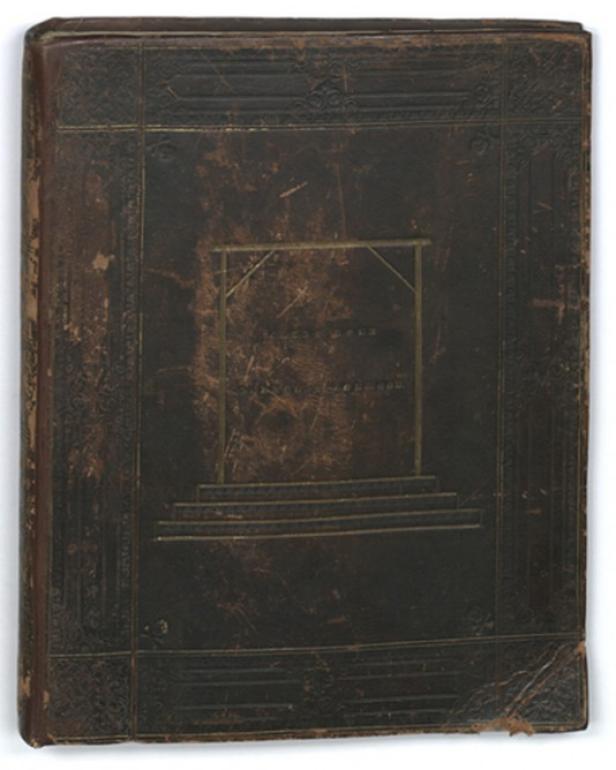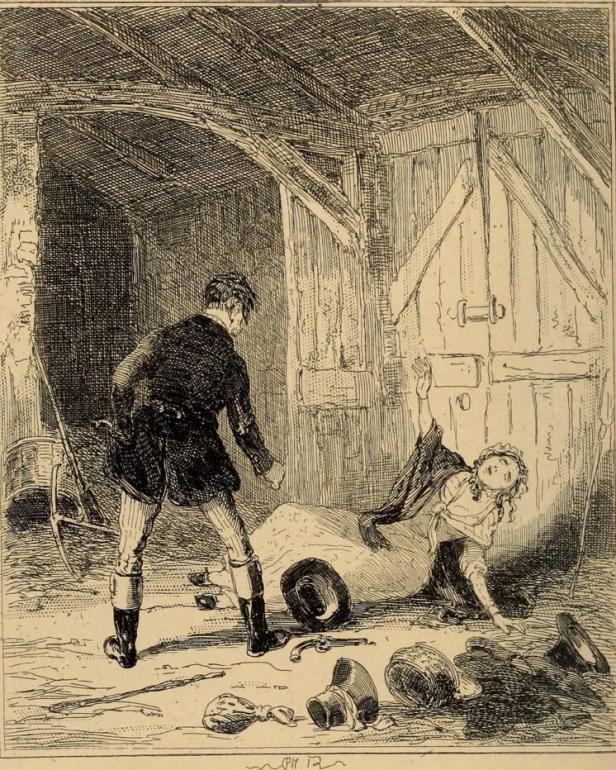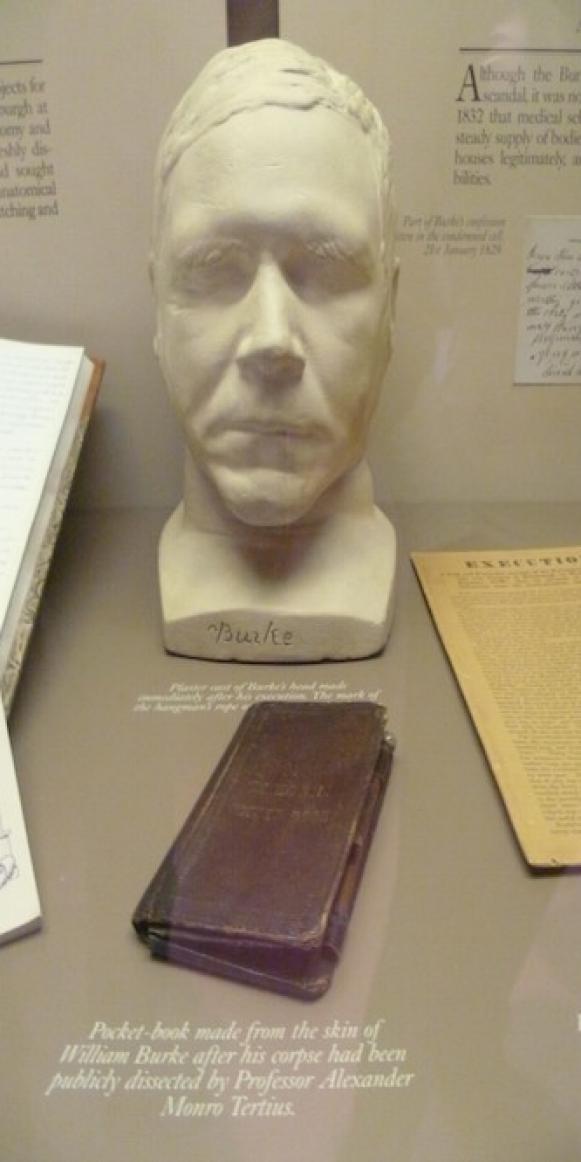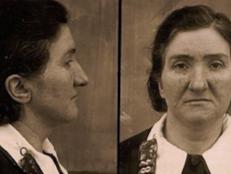7 Times The Skin Of Executed Criminals Was Used To Bind Books
Here are seven times the skin of executed criminals has been used to bind books, a practice called anthropodermic bibliopegy.

Calling card case made from the skin of William Burke [Kim Traynor via Wikimedia Commons]
Sometimes, executing a criminal just isn't punishment enough. Often, particularly in the 19th century, a body was taken down from the gallows and sent right to an anatomist at a medical school to be dissected for educational purposes. In some cases, this final indignity was considered part of the punishment. In rare instances, the corpse's skin was saved and used as bookbinding. Here are seven criminals who met that fate:
Father Henry Garnet of the Gunpowder Plot, executed 1606
An English Jesuit Priest, Garnet was imprisoned in the Tower of London and then executed for basically not being a snitch. He was a fan of solving problems nonviolently, and discouraged violent rebellion in favor of passive discourse. In 1605 he was informed of a plot to kill King James I. Although he was aware of the threat to the crown, he felt that he could not reveal it, as it was disclosed under confession. Despite the fact that the plot failed, Garnet was arrested for not having spoken out about what he knew, which was considered treason. He was executed by being hung, drawn, and quartered.
In 2007, a book came up for auction that is believe to be bound in Garnet's flesh. Entitled A True and Perfect Relation of the Whole Proceedings Against the Late Most Barbarous Traitors Garnet, a Jesuit, and His Confederates, the book was published just after Garnet's execution and is an account of his story. Some say they can see the image of Garnet's face on the cover.

The hanging of Father Henry Garnet [Mathias Tanner via Wikimedia Commons]
James Johnson, executed 1818
There is little information about this case, to the point where his crime even seems lost to history. But he was a criminal of some sort who was executed for his deeds. His skin was used to bind a volume of Samuel Johnson's (no relation)
John Horwood, murderer, executed 1821

The John Horwood book [BRO 35893/36/v_i, M Shed Museum]
Horwood had a dangerous and creepy infatuation with a woman named Eliza Balsum. She did not return his interest, despite that time he threw sulphuric acid at her. When he saw her with another man, he tried to win her favor by throwing a rock at her head, which didn't work either. She died four days later from a complication from the treatment for a fracture. After his hanging for her murder, his body was given to the same doctor who'd treated Balsum for use in a public dissection. The doctor himself tanned the skin after it was removed, using it to bind the story of the murder, trial, execution, and dissection. The tome is decorated with a gallows and little skulls and crossbones. It's currently held in the collection of the Bristol Record Office of the Bristol Museum, but is on public display at M Shed.
William Corder, the Red Barn Murder, executed 1828

William Corder and Maria Marten in the Red Barn [Internet Archive Book Images via Wikimedia Commons]
William Corder and Maria Marten in the Red Barn. Photo: By Internet Archive Book Images [No restrictions], via Wikimedia Commons[/caption]William Corder, 24, and Maria Marten, his 22-year-old lover were both known as trouble: she had had two children already, one of them by William's brother; he was a thief and a swindler, even victimizing his own father. Their romance was ill-fated, and Marten was on the verge of being prosecuted for her illegitimate children. The couple planned to head out of town and elope, arranging to meet at a red barn. Corder seemed to get cold feet, delaying their meeting more than once. When they finally did meet up, it was the last day Marten was seen alive. Corder gave various excuses as to her absence for months, but suspicion was mounting. After her stepmother had a dream in which she saw Marten being killed and her body hidden in a grain storage bin in the red barn, her family followed up on the dream. It turned out to be startlingly accurate, and her remains were discovered. Corder was tracked down in another city, with a new wife. He was put on trial and found guilty of her murder, although the motive was never clear.
He was hung in front of thousands, and his corpse was publicly dissected. He skin was tanned and use to bind a written account of the murder.

William Burke’s Death Mask and Pocket Book [Kim Traynor via WikimediaCommons]
William Burke, of Burke and Hare, executed 1829
Burke, with his partner in crime William Hare, was responsible for the deaths of 16 people. The duo murdered to sell fresh corpses for dissection to surgeon and anatomy teacher Dr. Robert Knox. Only Burke was hung for their crimes, as Hare testified against him. His body was dissected in front of hundreds of medical students, and then viewed by tens of thousands of people who wanted the thrill of seeing the infamous killer. His skin was used for various souvenirs, including a bookmark made for Charles Dickens. A "pocket book" with a Burke binding is in the collection of the Surgeons' Hall Museum in Edinburgh.
George Cudmore, murderer, executed 1830
He was hung for murdering his wife Grace on the urging of his lover Sarah Dunn — he was a professional rat catcher, and he used some of his arsenic-based poison in her meal of a roasted apple with milk. He was executed in front of a crowd of about 1,000, in Exeter, England. After his body was dissected at the Exeter and Devon Hospital, his skin was later used to bind an 1852 edition of The Poetical Works of John Milton. It's currently housed in the collection of the Westcountry Studies Library in Exeter, England.
James Allen, highwayman, died in prison, 1837
He was a man of many aliases — also known as George Walton, Jonas Pierce, James H. York, and Burley Grove, Allen was a Massachusetts highwayman. And a successful one at that, except for this one time when John Fenno, Jr., fought back and survived Allen's attack and resisted his robbery attempt. Fenno accused him of attempted murder, which led to his arrest.
At the end of his life of crime, Allen lived out his last days in prison. He delivered a deathbed confession of his deeds to the warden. One version of this manuscript, entitled the Narrative of the Life of James Allen, alias Jonas Pierce, alias James H. York, alias Burley Grove, the Highwayman, Being His Death-bed Confession to the Warden of the Massachusetts State Prison, was published bound in his flesh. Before his execution, Allen requested that the volume be given to Fenno, as a token of respect for standing up to him and surviving his gunshot wound. It remained in the collection of the Fenno family until 1905, when they donated it to the Boston Athenaeum. It has been fully digitized and is available for download.
There are many more examples of anthropodermic bibliopegy in the world, but these are the ones said to be made from the skin of criminals. But do we know for a fact that's true?
Megan Rosenbloom is the Associate Director for Collection Resources at the University of Southern California’s Norris Medical Library and a member of a team working to authenticate human-skin books.
Many of the alleged human-skin books the team has tested have turned out to be made from leather from sheep, pig, cow, or even just faux leather. Rosenbloom says the Allen book has been verified as definitely bound in human flesh.
The others have not been scientifically tested, at least not yet, but she is still fairly convinced they could be authentic. "Though the Corder and Burke books haven't been tested, they both have tons of provenance that makes me lean toward them being real," Rosenbloom says.
The Garnet one, however, raises a red flag for her. "1605 is very early for such a thing, so I have my suspicions, especially with that whole 'you can see his face on the cover' claim. Looks a bit sheepy to me, but you can never be sure just by looks alone."
Read more: Anthropodermic Books, Daily Mail, Bristol Museum, Wikipedia, Daily Mail, The Line-Up, BBC, Wikipedia, Odd Things Considered









